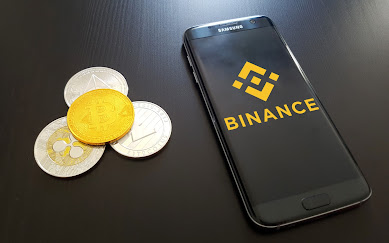what is Binance and how does it work?
what is Binance and how does it work?
We’ll cover everything you need to know about Bitcoin (BTC) and blockchain as it pertains to trading, investing, mining, or anything else you may be interested in learning more about today!
What Is Blockchain?
You probably have heard the word “blockchain” thrown around once or twice but if you just hear that term, your mind can conjure up an image of a giant spreadsheet with all sorts of numbers written on it. But it isn’t quite like this—and neither should we when talking specifically about crypto! Think of cryptocurrency as data and data is stored on blockchains. Blockchains store digital records (or in some cases, transactions) and their corresponding information (such as names and addresses). So, while we don’t see any actual physical books in our lives, cryptocurrencies are certainly not like paper bills or checks either.
Binance Overview To understand better, let’s take a look at one company that has recently gotten into the game. The first thing we need to do is figure out exactly who is behind Binance—and why did they decide to get involved in crypto. In fact, it may surprise you to learn that two people have actually founded Binance—the company now called Bitfinex. While each man is different, both are known for being extremely successful entrepreneurs. Bitfinex was founded by Robinhood co-founder Vlad Tenev in 2009, shortly after he had started his own payment firm. He launched Bitfinex, which remains its primary competitor in crypto, as well as serving as a broker for Coinbase, MetaMask, Gemini, and other popular exchanges.
Bitfinex continued to grow despite falling $100 million short of acquiring MyCoinbase. By 2014, Tenev had taken over from the CEO of another company in charge of the entire crypto industry in order to make Bitfinex bigger. This didn’t last, however. Shortly thereafter, Bitfinex came under fire from regulators, something Tenev’s CEO later admitted when he sued the Securities Exchange Commission (SEC). The SEC accused Bitcoin exchange Coinbase of using misleading and deceptive practices to hide losses incurred due to fraudulent activities. However, Tenev still wasn’t done, so six months later, Tenev stepped down from his post. That left the leadership team to pick up where he’d left off.
Since then, a search started for someone to fill the position. At first, the focus was on a former Goldman Sachs executive named Paul Tudor Jones, though Jones had also worked previously with Citigroup. Still, no luck there. When Tudor Jones couldn’t find anyone, a person named Tyler Winklevoss applied. Winklevoss was the founder and CEO of the software company LinkedIn, and since launching in 2003, he has helped create several major technologies such as Twitter, Instagram, Facebook, eBay, PayPal, Yahoo Messenger, Reddit, Google, Gmail, Pinterest, Microsoft Edge, Spotify, Mozilla Firefox, WhatsApp, and many others. Though Winklevoss was not involved directly, he played a crucial role in getting Binance onto the scene. As described above, Bitfinex is responsible for the majority of Binance’s assets, and most funds remain held in accounts owned by users.
It’s worth noting that Winklevoss didn’t personally oversee or manage the development of Binance. Instead, he provided funding to help develop the platform. Now, if you are familiar with the idea of crowdfunding platforms used by investors, then you can imagine that Winklevoss was the lead investor for his investments on these platforms. Therefore, he played a huge, and significant, role in helping build Binance. One interesting element of Binance is its ability to connect users around the world. Users can easily connect their bank accounts and send money across the globe, even without using wire transfers. On top of that, users can use BSC, Binance Smart Chain (BSC), or Binance Coin (BNB) in various ways, for example, by buying goods with fiat money on Amazon and elsewhere. Also important, Binance allows for the creation of multiple wallets and exchanges through Binance Payouts. This means that instead of receiving or sending payments through wires, users can simply choose between paying via mobile wallet or website.
The Future Of Cryptocurrency And Beyond.
At present, there seems to be nothing stopping Binance from taking action to improve its offerings. Some analysts believe that the move will soon give way to centralized finance, according to CNBC, meaning governments will be able to access user funds. They argue that these moves will eventually allow them access to all of the country’s wealth. Another aspect that could mean trouble is that Binance wants users to invest more than 100% in the project and cannot accept withdrawals because of regulations. There are rumors that the price of BNB could reach $10,000 in March 2022, and only 2.5% of those assets go through withdrawals. If you happen to lose more than 50%, expect a big fine. Even so, it wouldn’t seem too bad at the moment. With a relatively small volume of deposits, the market cap for Binance stands at $11 billion, so this scenario doesn’t seem as scary as it may seem.
Of course, the reality is far less glamorous than the above description. According to Bloomberg, global financial data analysts estimate an increase of 20% in value from the year 2020 to 2030. The U.S. Department of Labor predicts that every single business (and individual) would experience a massive increase in revenue by 2030. In addition, the growth of digital currencies like bitcoin (BTC) could potentially affect the balance sheet of traditional firms, whether large ones or small businesses. As the future looks bright for virtual currency and digital assets, crypto enthusiasts now have options in choosing a safe place to start investing. Whether Bitcoin and other blockchains will rise or fall is unclear.






Comments
Post a Comment